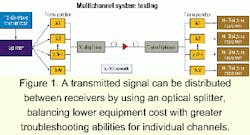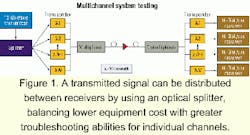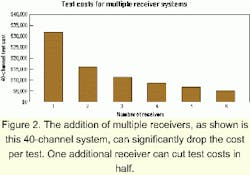Network operators deploy multichannel DWDM testing
Test equipment manufacturers race to keep up with the demands of network operators deploying into the public-switched telephone network.
PAUL FITZGERALD, Tektronix Inc.
The latest transmission equipment from established equipment suppliers and startups is rapidly being deployed in the public-switched telephone network. This wave of innovation, while attempting to meet the rising bandwidth demands of a post-Internet society, also increases the need for test equipment with large productivity gains to keep up with the demands of the network operators. Network operators are now able to deploy multichannel test equipment to turn up high-channel-count DWDM systems and achieve savings similar to those equipment manufacturers have reaped in their multichannel factory test systems.
The demand for more and more bandwidth is driving the need for increased network capacity, a requirement currently being met by deploying DWDM systems and higher transmission speeds. However, as channel counts increase, the possibilities for interactions between neighboring channels increase, as well. Similarly, as transmission speeds increase, the possibilities for timing problems increase. Thus, transmission equipment installation times are impacted. Improvements in test techniques are needed to overcome the challenges of deploying state-of-the-art transmission equipment.
Initially, DWDM systems based on 2.5 Gbits/sec were the industry's preferred choice. But the focus is now turning to bandwidth expansion by increasing the bit rate to 10 Gbits/sec in the core transport network. Although 10-Gbit/sec technologies are still at an early stage, the photonic challenges it presents are well defined and require the development of cost-effective test techniques to ensure signal integrity.
The expectation in the industry is that a test platform should last between eight and 10 years. However, photonic technology (in terms of speed and number of channels) is changing much more quickly-typically within one to two years. Therefore, any piece of test equipment has to be modular, flexible, and upgradable to be feasible for use in testing high-speed networks.
The ever-looming factor of cost needs to be addressed and controlled in test equipment and test methodologies, as network operators constantly upgrade systems to meet growing bandwidth needs while striving to remain competitive. As a result, network operators look at test equipment acquisition costs and test efficiencies when making purchase decisions.
Test equipment requirements are changing as fast as the technology they are testing. Having more bandwidth increases load capacities and data-transmission rates; therefore, the testing needed to verify and monitor these complex systems can quickly become overwhelming.
For example, it takes eight hours to test a single 10-Gbit/sec channel to obtain 95% certainty that the bit-error ratio is 10-14 or better, provided no errors were recorded during that time.* Testing at a 95% confidence level for an eight-channel system will take almost three days, a 16-channel system almost six days, and a 40-channel system almost 13 days (see Table). Therefore, using just one set of test equipment, the cost in test time soars astronomically with the addition of more bandwidth and, thus, more channels.Some installers use loopback testing as a way to reduce test equipment costs. This testing method links the output of a test transmitter to a series of connected network elements and finally to the test equipment receiver. However, this method limits the ability to effectively isolate errors on individual channels. So where there may be initial savings in test equipment cost, ultimately there is a loss in the labor and time required to track individual problems through the loopbacked signals-and important turn-up schedules can be missed.
The other standard test method-end-to-end testing-simply takes too long. With end-to-end testing, the channels are checked one at a time with one set of test equipment. Test equipment needs are fairly minimal since the same equipment is used to test each line. However, the test times quickly become astronomical as the number of channels in the system increases.
There is a solution to this dilemma. The multichannel test method uses a small number of transmitters and splits the signal between a larger number of receivers. Each channel has a devoted receiver, but uses a shared transmitter. The transmitter is shared by use of an optical splitter to distribute the transmitted signal between the receivers (see Figure 1). This method balances a lower equipment cost with the greater troubleshooting abilities of monitoring each channel individually.
Using multiple receivers linked to one transmitter allows the tests to be performed faster and provides more efficiency within the system in tracking down problems. Unlike a loopback system, where the error cannot be traced easily to its source, the multichannel system has a receiver devoted to each channel and provides the ability to quickly identify faulty channels.Multiple receivers can also help when loopback testing is the preferred method. By using multiple receivers, the system under test can be broken into sections, each with an isolated loopback system composed of a receiver and a smaller number of channels. Thus, if an error is introduced into the loopbacked signal, only the section involved need be checked, instead of the complete system. In this way, the limitations of loopback testing are minimized.
For example, if a ratio of one transmitter to three receivers (1:3) is used to test a 40-channel system using the loopback method, three different transmission loops are set up with one receiver monitoring each isolated loop. Figure 2 shows the costs associated with testing a 40-channel system using multiple receivers. These figures were derived using $100 per hour as typical loaded labor costs for testing a 40-channel system.
As demonstrated, the addition of multiple receivers significantly drops the price per test. If just one additional receiver is added to increase channel-testing capabilities, the cost to test the system is cut in half. Since receivers are typically less expensive than transmitters or transceivers, outfitting installation and maintenance teams with multichannel test sets is also cost effective.Another added benefit of testing with multiple receivers is that the system always remains upgradable. If greater amounts of transmission channels need to be turned up in a short period of time, then simply add more receivers and transmitters. There is no need to touch existing test setups to reconfigure the system to accommodate the additional channels.
Putting it all together, multichannel testing reduces costly test times and equipment needs. It's best to use single transmitters with optical splitters to drive multiple receivers for better performance monitoring and lower test times. Multichannel testing is the best solution for installing and testing high-speed multichannel systems. It gives network operators the ability to perform faster turn-ups of today's highly complex systems. Multichannel testing is an important gain in system test productivity.
Paul Fitzgerald is product manager for the telecommunications-equipment manufacturers broadband transmission test division of Tektronix Inc. (Beaverton, OR). He can be reached via the company's Website, www.tektronix.com.
These statistics were derived from the formula T=(-ln(1-C))/r, where C is the confidence level and r the specified error rate. More information on this method is available from the Tektronix technical brief "Measure Error Rates Quickly and Accurately" (Tektronix literature #2RA-11560-00).



